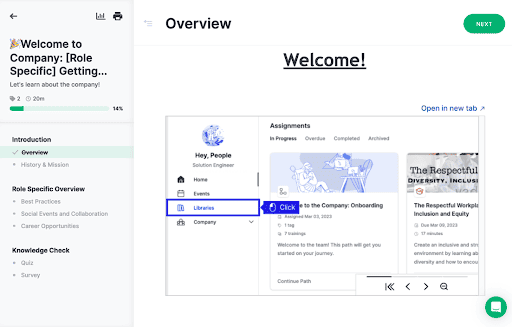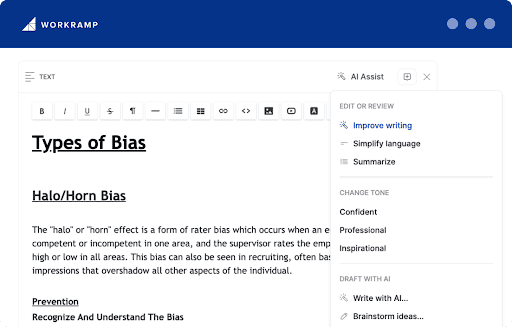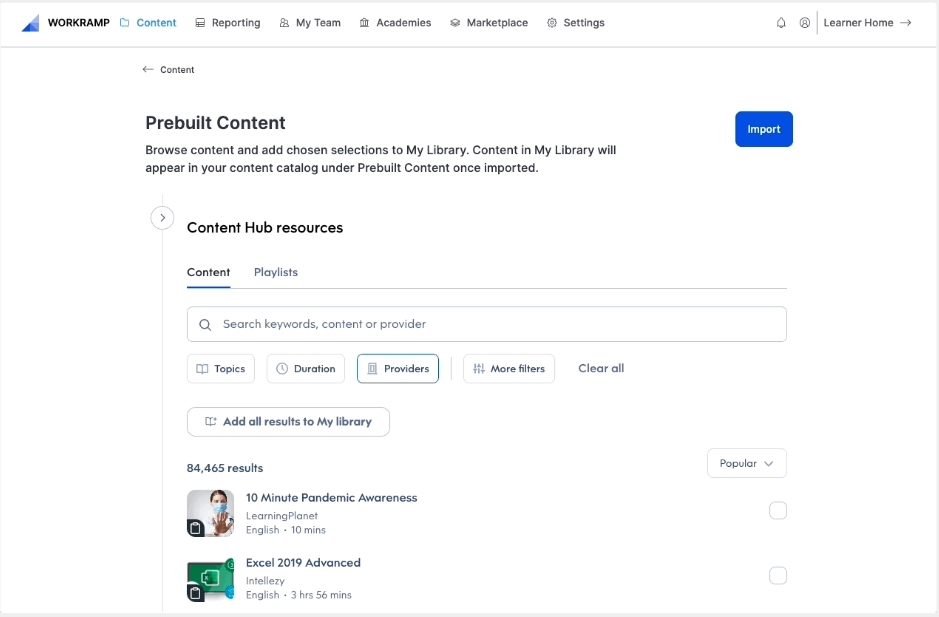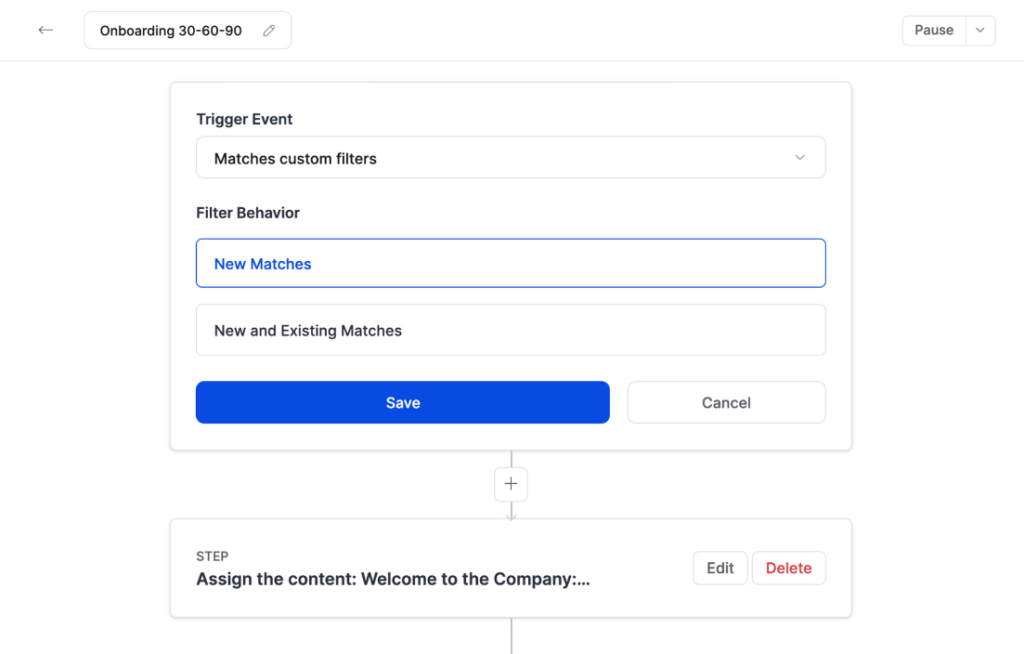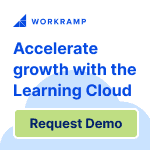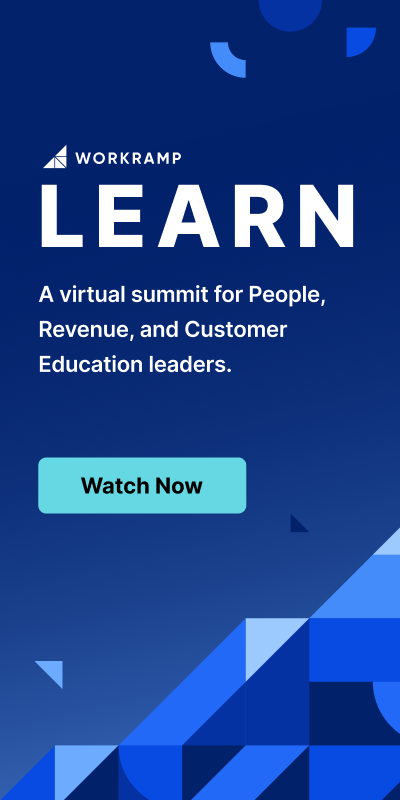11 Best AI Learning Platforms
Elise Dopson | WorkRamp Contributor
View bioLearning Tips Straight to Your Inbox
To say artificial intelligence is taking over would be an understatement. Almost every organization is incorporating technology into their operations—the learning and development industry is no different.
LinkedIn’s recent Workplace Learning report found that four in five L&D professionals want to learn more about how they can use AI in their profession. It’s why nine in 10 executives plan to increase or keep steady their AI investment over the coming year.
Many learning management systems are incorporating AI features to help organizations extract value from AI without building their own machine learning models or building an extensive tool stack of AI tools each with their own subscription fees and capabilities.
This guide shares what an AI learning platform does, how your organization can benefit from one, and the top providers to consider when starting your search for a new AI LMS.
In this post:
What is an AI learning platform?
An AI learning platform is a learning management system that uses artificial intelligence and machine learning technology to improve the learner experience. The AI LMS collects and interprets learner data to personalize learning materials, recommend training modules, and automatically curate content—all without any input or manual work from the training facilitator.
AI learning platforms also help L&D managers operate their programs more efficiently. Artificial intelligence can highlight any skills gaps in your current team, or content gaps in your existing training modules. It can even use predictive analytics to estimate how effective future content will be at meeting learning objectives.
The end result is a library of optimized training materials that address skills gaps, maintain compliance, and encourage students to learn.
AI learning platform example
WorkRamp is an example of an AI learning platform. Capable of housing internal and external training programs under one roof, WorkRamp offers AI Assist that let you:
- Generate new content based on a prompt
- Adjust the tone and personality of training materials
- Localize content by translating learning content into other languages
- Repurpose existing content into other formats: images, checklists, or video transcripts
- Use AI-powered role-play bots to replicate scenarios without risk (such as difficult customer interactions or sales calls)
AI learning use cases
Artificial intelligence is infiltrating almost every part of L&D. Here are some common use cases for how to implement it within your programs.
AI tools for training and development
Employee training addresses any skills gaps in your organization and brings new hires up to speed with how you operate. It also helps maintain compliance and avoid the $14.8 billion that organizations spend on non-compliance issues.
Practical examples of how to use WorkRamp AI for training include:
- Compliance and regulatory research to ensure content is up to date and fit for purpose
- Repurposing content into other formats, like automated video transcription or translation
- Providing real-time feedback that removes the administrative legwork of writing 1-to-1 responses
AI learning platforms for students
AI doesn’t just benefit training facilitators. Students can also benefit from features like learning paths that offer intelligent content recommendations based on each individual’s skills gaps, or virtual tutoring to provide instant feedback on online quizzes or end-of-module tests.
You can even launch gamified learning experiences, such as contests and leaderboards, to build a culture of learning amongst students.
Engaging customers with artificial intelligence
The best LMSes can be used to train different personas—not just employees. WorkRamp, for example, is an all-in-one platform that lets you train partners and customers, without investing in a completely new system that sits adjacent to your employee L&D initiatives.
Say you’re launching a customer education academy to increase customer retention for a CRM company. The AI feature could use the data you’ve collected on a customer to offer intelligent content recommendations. People working at Fortune 500 companies get more advanced training, whereas those with just one person on the subscription plan are recommended for your “CRM basics” module.
Discover Real-World Examples of AI in Customer Education
Benefits of an AI-based learning platform
AI LMSes go a step further than simply being a place to store learning materials. The benefits on offer include:
Faster content creation
Generative AI is a machine learning model that uses neural networks to identify patterns and structure within content in its datasets. This means that when you feed the generative AI feature a prompt, it can produce content that sounds like a human wrote it.
In the context of learning and development: learning platforms with native generative AI functionality can create:
- Course structures or module outlines
- Video and images, without actually shooting them yourself
- Student notifications, like in-app notifications that notify learners about soon-to-expire compliance certificates
- Answers to learner FAQs, like “How do I access this course?” or “Which module do I need to take next?”
- Multiple-choice questions to measure knowledge retention
For more ways AI can streamline your content creation process, explore our guide to AI tools for LMS content curation.
Personalized learning
Personalized learning takes each individual’s goals, needs, and existing skills into account when delivering training materials. The traditional L&D approach, which involved hiring a meeting room and addressing a large group of people at the same time, made this almost impossible.
AI learning platforms, however, can take data you’ve already collected on your students to create personalized learning paths. For example: if you’re onboarding a new employee who got below-average scores for the end-of-module test in your cybersecurity module, the AI could flag this grade and divert the learner to a more comprehensive training video on the topic.
Workflow and task automation
There are many moving parts associated with an L&D program—most of which are repetitive tasks that don’t necessarily need human input.
Examples of tasks that can be automated using AI inside your LMS include:
- Test or quiz grading
- Providing learner feedback
- Tracking and awarding rewards for completing training tasks
- Compliance renewal reminders
- Generating reports
The clear benefit is increased productivity. Less time spent on manual tasks gives you more time to focus on bigger-picture strategies. In fact, studies have proven that AI can impact performance by almost 40 percent.
Workflow and task automation also remove the risk of human error wreaking havoc on your L&D initiatives—from basic errors (like spelling mistakes) to bigger issues (like adding an extra zero on the end of an LMS report and severely underestimating the ROI of your LMS).
Cost efficiency
Granted, there is a cost associated with implementing a new AI learning platform. You’ll need to account for licensing, onboarding, and training costs when incorporating new technology into your L&D programs.
That said, the investment can pay dividends—not just in the short term when training facilitators use automation to complete repetitive tasks, but in the long run. Learners interacting with an AI learning platform get personalized training materials, which have been demonstrated to improve results.
Best AI learning platforms
Unsure where to start on your search for an AI-powered LMS? Here are 11 of the best vendors and their key features.
1. WorkRamp
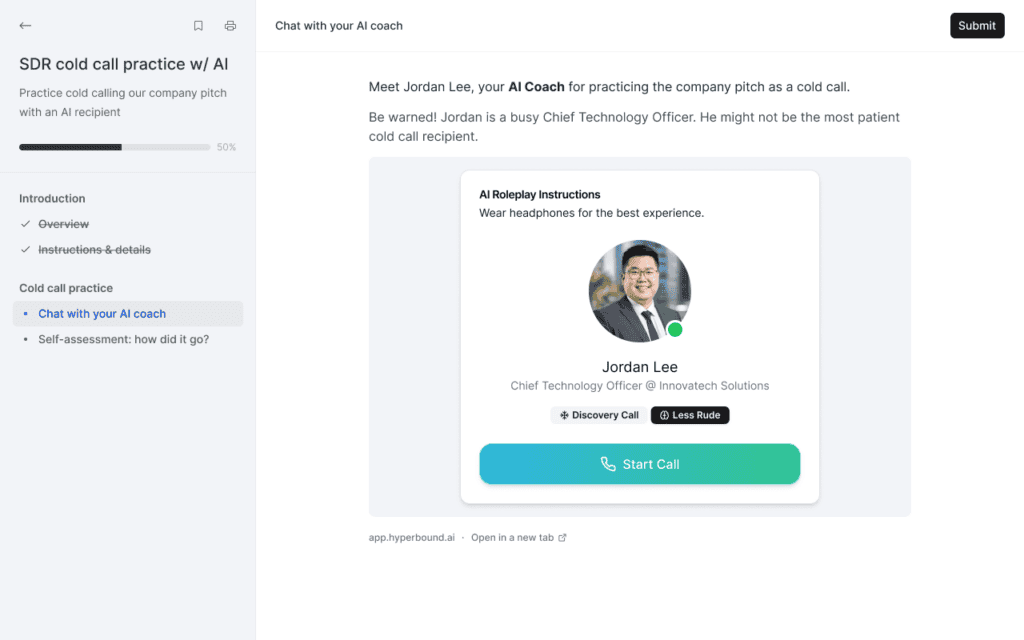
WorkRamp’s learning platform has artificial intelligence features baked in, so you don’t have to manage multiple logins for different AI platforms. This includes AI Assist, a generative AI feature to help you create and improve learning materials, and AI Practice, an AI-driven role-playing bot that simulates common scenarios to help students learn by doing.
Key features include:
- “Draft with AI” tool to brainstorm ideas, write an introduction, or make an outline for training modules
- Customizable learning paths that recommend training materials based on student data
- Interactive content and challenges to incentivize learners to participate
- Content repurposing to turn written text into images, checklists, and multiple-choice quizzes that cater to multimodal learning
- AI-powered role-playing bots to train your sales team in a safe environment before they interact with potential customers
- Integrations with tools like Gong, Zendesk, Salesforce, Lattice HRIS, and BambooHR
“WorkRamp gives us the same experience that we provide to our customers–simple, elegant, and a joy to do business with,” says Morgan Murphy, manager of sales enablement at Sprout Social. “Beyond the product being so easy and fun to work in, the company as a whole checks the boxes on the values that we look for in a software partner.”
See how WorkRamp can improve efficiency and help you deliver world-class learning experiences by scheduling a free demo today.
2. 360Learning
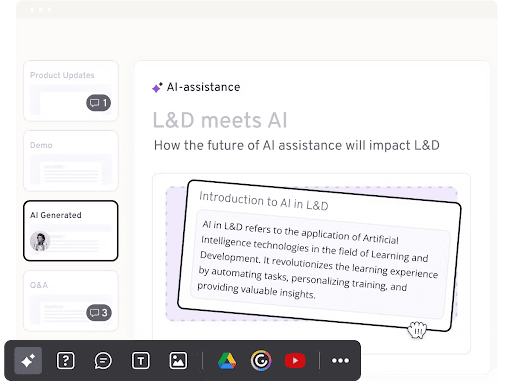
360Learning is an AI learning platform that focuses on collaborative learning. The idea is that students and teachers work together to produce training materials, with AI features that assist the content creation process.
Key features include:
- Course builder to create new learning content on a prompt
- Automatic certifications
- Content translation
- AI-based content recommendations
- AI-driven benchmarks that use LMS data to measure learner proficiency
3. Safety Culture

Safety Culture, formerly known as EdApp, is an AI LMS built for mobile with apps for students to download to their smartphones. Its goal is to help L&D managers encourage microlearning—where students digest learning materials in bite-sized chunks, as opposed to time-intensive courses.
Key features include:
- “Create with AI” to produce course content or answers to FAQs
- Mobile app to build learning content on the go
- Template library with over 80+ options to choose from
- PowerPoint converter
- Native reporting and analytics features
4. Teachable

Teachable is an online course builder originally designed for creators. It has since launched an enterprise LMS that incorporates AI to help businesses launch customer education and internal training courses.
Key features include:
- AI curriculum generator to outline course content
- Quiz generator
- Summary generator to condense long lessons
- Auto-generated video subtitles and translations
- AI-powered writing assistant
5. Docebo
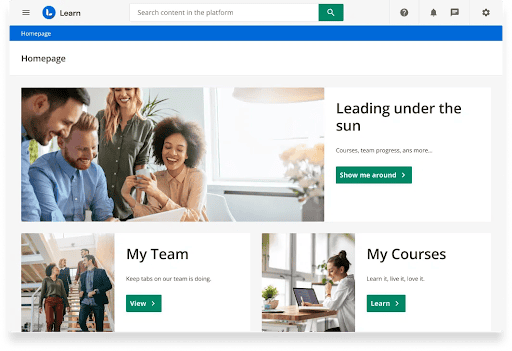
Docebo’s learning management system helps L&D managers automate repetitive tasks, such as tagging training materials and making intelligent content suggestions. It recently acquired Edugo to expand its AI capabilities and introduce new features to the LMS.
Key features include:
- Autotagging learning content for easy searchability
- AI-powered search features to surface relevant materials
- Automatic skill assignment
- Intelligent content recommendations
- Content translation
6. Absorb LMS
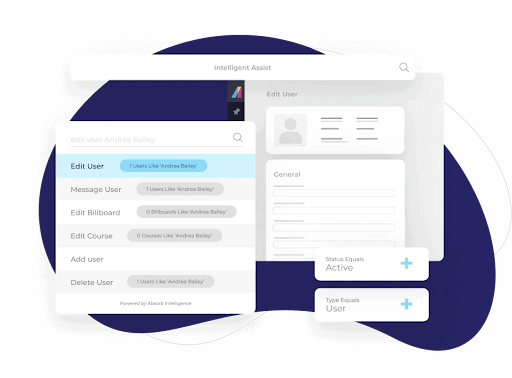
Absorb is a popular cloud-based LMS amongst mid-market and enterprise brands. Known for its minimalistic interface and reporting features, Absorb also offers AI features that help facilitators create content quickly, and learners find it.
Key features include:
- AI course builder, including a library of prebuilt courses
- Smart content recommendations
- Intelligent Assist, which you can use to answer questions and find data
- Intelligent Ranking, which reorders search results for each learner
7. eduMe

eduMe’s LMS specializes in employee training content. Its standout feature is a PDF converter that can turn traditional training content into engaging short-form video clips not too dissimilar to TikTok.
Key features include:
- Lesson scoring to prioritize content updates
- Personalized recommendations on how to improve lesson scores
- Auto-translation for written content
- PDF conversion into microlearning materials, like TikTok-style clips
8. Cornerstone OnDemand
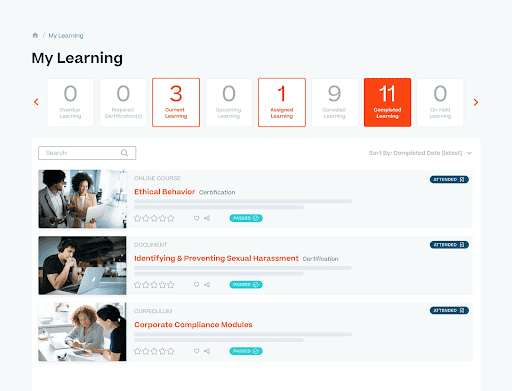
Cornerstone OnDemand is an enterprise LMS that acts as a personalized learning coach for your students. It suggests learning modules that fill skills gaps or are most relevant to each employee’s role.
Key features include:
- Generative AI to create, translate, and curate learning content
- Intelligent content recommendations based on student skills and roles
- Mobile app to encourage microlearning
- Compliance workflows to maintain compliance
9. Sana Labs

Sana Labs is a knowledge base tool with a native LMS. It has AI capabilities that help you create internal documentation in a fraction of the time it’d take to do it manually, as well as support for interactive content formats like polls, reflection cards, and quizzes.
Key features include:
- AI video generator using avatars
- Translation in over 130 languages
- Personalized quizzes to encourage knowledge retention
- Rule creator to configure workflows and automations
10. Paradiso Solutions
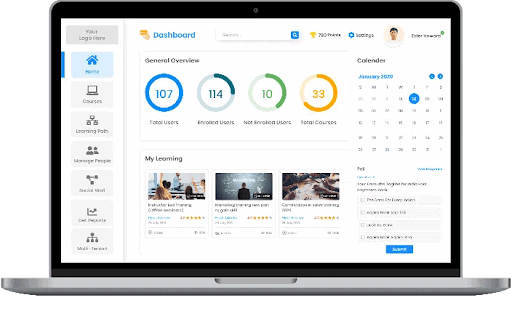
Paradiso Solutions has a cloud-based and on-premise LMS solution that includes AI capabilities. Its standout AI feature is CogniSpark, an eLearning authoring tool that lets training facilitators produce new content.
Key features include:
- Generative AI for course content creation
- Personalized learning paths
- AI analytics and reporting
- Automated grading and assessment feedback
11. LearnUpon
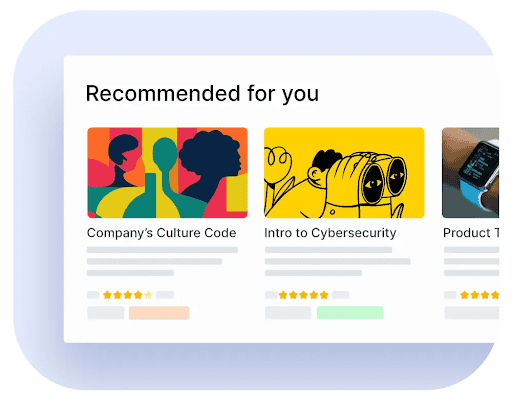
LearnUpon’s AI learning platform offers several features designed to improve the learning experience and make it easier for facilitators to deliver L&D programs.
Key features include:
- Interactive bots and AI coaching
- Exam builder to assess learner comprehension
- Automated content recommendations
- AI notifications to encourage learning and gather feedback
Features to look for in an AI learning platform
Now that we’ve shortlisted potential LMS providers, let’s review the features you’ll need to look for when choosing an AI LMS platform.
Generating training content
There’s a lot of ground to cover when producing L&D programs—not all topics are your area of expertise. Instead of becoming an expert in niche topics like cybersecurity, health and safety, sales, or management, generative AI can summarize key concepts and research reports, and then incorporate them into training materials for you.
In a recent interview with WorkRamp, Jasper’s head of customer education Sara Patel said: “Generative AI is here to stay, and like many have said, it’s not about generative AI taking a marketer’s job–I don’t see that happening, but a marketer who uses generative AI proficiently will definitely have an edge over someone who doesn’t use it at all or doesn’t use it well.”
⚡️Pro tip: Combine generative AI with pre-built content inside WorkRamp’s AI learning platform. All prebuilt modules are authored by experts to cover the core training components, but you can use AI Assist to make it unique by rewriting it in your business’s tone of voice.
In-depth data analysis
Learning management systems collect a wealth of data about your learners. The onus, however, doesn’t have to be on you to interpret the data and extract meaningful insights. Artificial intelligence can do it for you, while also improving accuracy and removing the risk of human error.
AI reporting features can also future-proof your programs using predictive analytics. In the case of a software brand: AI might recognize that a certain coding language is gaining popularity, so the LMS sends a notification to your L&D manager with recommendations to address it—either in a new course or by updating existing content.
Adaptive content for different learning paths
What’s especially great about an AI learning platform is that they can act on insights they find. If a learner fails their end-of-module quiz, for example, the AI feature can offer intelligent content recommendations that point to courses that cover the topic in greater depth.
Similarly, some platforms dynamically change content based on data they’ve collected on learners. Say you’re using an AI-powered LMS to train developers. If a junior developer struggles with a certain coding concept, the content can adjust and offer extra tutorials or practice exercises before moving to the next module.
More advanced learners can bypass these extra modules, which keeps engagement high. They don’t need to spend time learning about topics they’re confident with.
Content translation
Modern teams are more distributed than ever. It’s not uncommon to have learners who live in different countries and speak a native language other than English.
Help these learners interact with your content with an AI learning platform that offers automatic translation. It bypasses the need to pay for expensive translation services and the slow turnaround times that many agencies offer. Generative AI can do it accurately within a matter of minutes.
This is especially important if you’re using your AI LMS to train customers. One study found that over two-thirds of consumers prefer to speak with brands in their native language. They also put a $500 ceiling on how much they’re willing to spend with brands that don’t offer native language support.
Virtual assistants or chatbots
A student has a question about a particular learning module. Standard practice would be to signpost them to an L&D manager—or perhaps your LMS community forum where they can get feedback from other learners.
A better approach, however, would be to make an AI chatbot easily accessible throughout each learning interaction. They’ll get immediate responses to their questions, helping them work through the module without having to wait for a response.
Students are more open to this type of communication than you might think: two-thirds of millennials expect the real-time customer service that chatbots offer.
AI coaching
Learning and development is an iterative process. What works for one student won’t be the best approach for another. This is where AI coaching functionality shines.
WorkRamp, for example, has a native sales coaching feature that uses Hyperbound AI to train reps. Run dynamic simulations that replicate common scenarios in a safe and controlled environment, such as:
- Calls with difficult customers
- Conversations where the customer says a particular sales objection
- Discussions with particular customer personas
“By making Hyperbound’s AI-driven role play embeddable within the Learning Cloud, we’re doubling down on our mission to create an LMS that’s innovative, intelligent, and fully integrated,” said WorkRamp’s CEO and co-founder Ted Blosser. “We’re excited about leveraging AI to address a critical need in sales training and ultimately support teams in accelerating skill development and improving win rates.”
Want to see how AI-powered coaching tools are changing the game? Check out how AI is transforming sales coaching.
Choose the best AI-powered LMS
There’s a lot that goes into your decision to migrate LMS providers. The new system needs to offer the AI features your organization needs to improve the learning experience and improve operational efficiency—without the coding knowledge that facilitators traditionally needed to make the most out of AI.
WorkRamp does this with ease. Features like AI Assist and AI Practice are designed with ease of use in mind, letting you tap into the power of AI without feeling overwhelmed by the setup process.
Frequently Asked Questions
What is an AI learning platform?
An AI learning platform is a learning management system (LMS) that uses artificial intelligence to personalize learning experiences, automate tasks, and provide deeper data insights.
How can AI improve employee training?
AI can personalize training paths, automate repetitive tasks like grading and feedback, and surface skill gaps so L&D teams can focus on strategy—not manual work.
Do I need technical knowledge to use an AI LMS?
No. Modern AI-powered LMS platforms like WorkRamp are designed for ease of use, so you can tap into AI without needing coding or machine learning experience.
Can AI help with compliance training?
Yes. AI tools can ensure content stays up to date, automatically notify learners of expiring certifications, and generate content that meets regulatory standards.
What’s the difference between a regular LMS and an AI-powered one?
An AI-powered LMS goes beyond storing training materials—it uses data and automation to improve learning outcomes, personalize content, and increase efficiency.
Discover how WorkRamp can help you run a more efficient L&D program. Schedule a free, personalized demo of WorkRamp’s AI learning platform today.
Complete the form for a custom demo.
Recent Posts
- 11 AI LMS for AI-Powered Learning June 27, 2025
- The Best LMS Platforms for Customer Retention (2025 Guide) June 27, 2025
- 11 Best AI Learning Platforms June 16, 2025
- Top AI LMS Features (and Why They Matter in 2025) June 16, 2025
- Top Learning Management Tools in 2025 June 6, 2025
Elise Dopson
WorkRamp ContributorElise Dopson is a freelance writer for B2B SaaS companies. She’s also the co-founder of Peak Freelance and mom to an adorable Spaniel pup.
You might also like
Explore the top AI LMS platforms for advanced AI-powered learning. Enhance education with smart, adaptive technology solutions.
Explore the top AI LMS platforms for advanced AI-powered learning. Enhance education with smart, adaptive technology solutions.
Read More
The Top 3 LMS Platforms for Customer Retention in 2025
Looking to turn new customers into loyal advocates? The right Learning Management System (LMS) can help you do just that by boosting satisfaction, reducing churn, and even driving revenue growth. Here’s why it matters: keeping customers is 5–7 times cheaper than acquiring new ones, and just a 5% increase in retention can lead to a […]
Read More
Discover the Best AI Learning Platforms
Unlock the future of tech with our review of the best AI learning platforms in 2024. Dive into cutting-edge AI-powered learning today.
Read More
Top AI LMS Features Transforming Training in 2025
AI in Learning Management Systems (LMS) isn’t just a buzzword—it’s transforming how companies deliver, manage, and optimize employee training. The best AI LMS features include: Personalized learning paths Automated content creation and updates Real-time analytics and dashboards Skills gap analysis Multilingual localization Adaptive assessments and simulations Together, these features help teams train more efficiently, improve […]
Read More
Explore the top Learning Management Tools in 2025
Modern training demands flexible, scalable, and results-driven solutions—and that’s where learning management tools come in. From content authoring platforms to full-scale Learning Management Systems (LMS), today’s tools help companies onboard faster, upskill smarter, and scale training with AI. In this guide, we’ll break down what to look for in 2025’s top learning management tools, spotlight […]
Read More
What is multimodal learning?
Creating a learning environment that considers your team's different needs isn’t easy. Here’s how to identify individual employee learning styles and create a development plan that engages your team.
Read More

